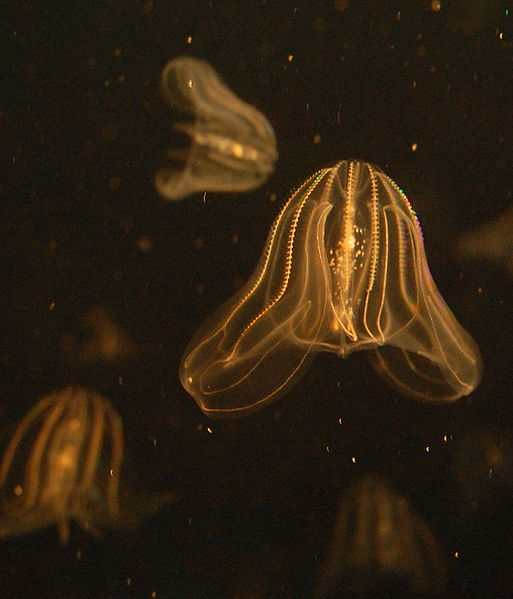
I've used this joke before but I just can't resist. . . "Luke, I am your father!" The ctenophore (comb jelly) Mnemiopsis leidyi. Creative Commons Steven G. Johnson
Remember comb jellies? The awesomely awesome spacecraft-shaped transparent oceanic stealth predators? I did a post about their general biology for Halloween last year.
When I was in Hawaii last April on my amazing pelagic night dive, I observed two comb jelly behaviors that totally startled me: just as I turned to look at one, it abruptly sucked a pink krill into its transparent stomach. (I’m glad I can’t watch *you* digest your lunch) And shortly after, it swam off under its own jet power, sucking in water and shooting it out through its muscular lobes. From watching the docile specimens found in aquaria — which never so much as lifted a lobe to exert themselves under their own power — I falsely assumed they were incapable of moving anything other than their cilia. But as it turns out, moving their cilia may be more than enough to lure the unsuspecting microscopic contents of entire seas to their doom. And “stealth predators” seems to be an understatement.
The species Mnemiopsis leidyi, originally native to the western Atlantic, but coming to a soon-to-be formerly pristine body of water near you (courtesy ship ballast water), is able to use its cilia to create a current of water fast enough to deliver its food to its mouth, but not so fast as to alert the unsuspecting foodstuff that it is . . . well. . . future foodstuff. Sneaky. Very sneaky. This according to a recent paper in the Proceedings of the National Academy of Sciences.
Understanding this ability may be greatly helpful in understanding how M. leidyi nearly emptied out the krill and small fish populations of the Black and Caspian Seas in the late 1980s and is well on its way to repeating the feat in the Baltic. Mnemiopsis was introduced into an overfished and polluted Black Sea in the 1980s, where it capitalized on struggling fish stocks to reach more than 10 animals per cubic foot in some places by 1989. The comb jelly ate the small fry of commercial fish like anchovy, causing a further drop in fish populations. Since then, the collapse of Black Sea fisheries, the decrease in pollution caused by the collapse of the Soviet Union, and the accidental introduction of another invasive comb jelly that preys on Mnemiopsis have curtailed its numbers somewhat. But lately the hardy jelly has also wreaked havoc in Israel, where gelatinous blooms gummed up the filters of a desalination plant, stanching a third of its 100 million liter daily flow; in the Caspian Sea, where it was introduced in 1999 and depleted 75% of the zooplankton;in the North Sea and western Baltic, which the comb jelly found its way into by hook or crook in 2006; and in the Mediterranean waters off Italy where it was first sighted just last year, causing local fisteries experts to fear for their stocks.
Though, as wikipedia calls it, this tentaculate ctenophore (say that 10 times fast) seems to be slowly taking over world waters (as are many jellies in the vacuum left by overfishing), that does not take away from its extraordinary ability to earn its daily bread in the same way you can cook a frog human(see comments : ) ) not by throwing it in a pot of boiling water, but by putting it in cold water and slowly turning up the heat. And though I’ve never seen one do its stuff in person (I was in the North Pacific when I saw my comb jelly, where this ctenophore species does not yet seem to have reached), I’m sure I’d still be excited if I did. Just as rock snot is destructive and ugly macroscopically but gorgeous up close, were one to look up close at the teeming ctenophore hordes that are doing so much damage to the fish stocks of Europe, one would find their cilia twinkle in the light, and, delightfully, glow blue green in the dark when disturbed. Coooooool.


{ 2 trackbacks }
{ 2 comments… read them below or add one }
Jennifer, frogs don’t actually do that. It’s a myth. If you raise the water temperature they jump out.
Humans are the animals that misinterpret their environment and slowly cook. Frogs jump.
Yes, now that I look it up that’s true. I’ll make a quick change. : )